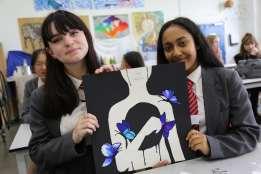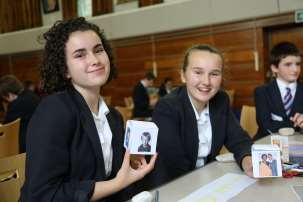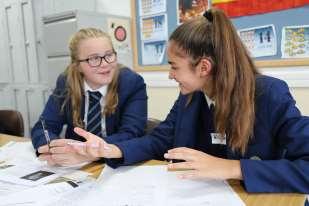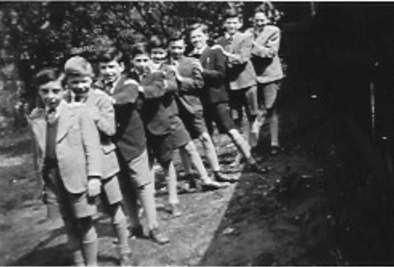
10 minute read
animation project p2
3 Reflecting through art, animation & poetry
“I think that it is important to make other people aware of what the survivors of the Holocaust and other genocides went through. If our words and drawings help others in our community think about the experiences of Zigi, Kemal and Sophie then that is a good thing.”
This is how one of the Year 9 students hopes their work will impact our local community as Holocaust Memorial Day approaches. After hearing the testimony of Zigi Shipper, Kemal Pervanic and Sophie Masereka the students reflected on what they had heard in various workshops. They responded through art, animation, poetry and exhibition building.
Art
With the help of expert Holocaust art educator Caroline Slifkin, the students created pieces that summarised their thoughts on what they had heard about the Holocaust and other genocides.

4 Reflecting through art, animation, poetry...

Animation
The students took part in an animation workshop to reflect on what they had heard. The outcome was a creation that animated themes of resistance, hate speech, empathy, division, discrimination, community, isolation and standing together.
Poetry
The performance poet, Kat Francois, ran a workshop with a group of the students. The young poets created pieces based on the testimony that they had heard.

Journalism
Budding journalists used the power of the pen to help raise awareness of the Holocaust and other genocides. The copy that they produced can be read in the opening pages of this newspaper! The reports that you’re reading now were created with the help of Ms Bartholomew from Hampton School’s English Department.
Raising awareness through posters
Raising awareness in our local community of the Holocaust and other genocides was a key part of the work of the students. They created posters that told the stories of Zigi, Kemal and Sophie to educate others.


Standing Together
Sunny and Sophie created pieces of art that reflected on the experiences of Zigi (left) and Sophie (right). By thinking about the events that the survivors went through the artists recognise the need to ‘Stand Together’ with all those who suffer discrimination.
5 ...and awareness raising posters
The posters were collaboratively created by Abdul , Louis, Max, Archie, Ruby, Eli, Jared, Tom, Ashley, Anya, Kiara, Humma, Ben, Shigda, Loza, Millie, Sheral, Sapna, Martyna, Adam, Charlotte, Phea, Annabel, Sienna, Katherine, Tom, Grace, Liv, Simran, Lucia, Brianna, Stanley and Klay. The students come from Christ’s School, Grey Court School, St Richard Reynolds Catholic College, Turing House School, Hampton High, Lady Eleanor Holles School, Reach Academy and Tolworth Girls’ School.
Foundation Stones
A new Holocaust memorial is scheduled to be built right next to the Houses of Parliament. If the memorial gets the go ahead the foundations will include memorial stones sent in by the public. As part of a workshop pupils decorated stones with drawings, symbols and messages . They used the testimony of Zigi, Kemal and Sophie as inspiration. The stones will be sent to the new memorial for inclusion in its foundations.

6 Researching those deported to Auschwitz
To help our community understand more about Auschwitz-Birkenau students from several schools around the local area have been researching the lives of individuals deported there during World War Two. Young people from Turing House School, Orleans Park School, Teddington School and Hampton School have collaborated on a project to bring together the biographies of seventy five individuals who were deported to Auschwitz. The students got to know more about the composers, pets, footballers, actors, directors, men, women and children who's lives were cruelly destroyed by the Nazi regime. 'Before the project all I knew about Auschwitz were the statistics. I didn't know anything about the people who were sent there.' said Jack from Turing House School. 'Now I know something about a few of those who perished. They came from all over Europe and had friends, families, hopes and dreams like the rest of us. Knowing more about Auschwitz-Birkenau makes me realised even more the importance of remembering the people who were sent there.' The students have been posting the pictures and biographies of the individuals they researched on Twitter since before Christmas where they have been viewed thousands of times. At the time of writing the profiles have been seen by more than 100,000 people. You can learn about those they researched on Twitter @genocide8020.
Elisabeth from Orleans Park School researched Itzhak Katznelson. He was a teacher & poet. Itzhak was imprisoned in the Warsaw ghetto and, after his wife and two sons were murdered, Itzhak took part in the Ghetto uprising. In April 1944 Itzhak and his remaining son were deported to Auschwitz where they were murdered on May 1st 1944. One of the research team from Teddington School found out about Marcel Nadjari. He was born in Greece in 1917 & was a solider from 1937-40. Deported to Auschwitz in 1944, Marcel worked as part of the Sonderkommando in Krematorium III. Assuming that he would die, he wrote a description of the camp & buried it so that the world would know. Marcel survived. Maggie from Turing House School discovered the life of Alice Licht was born in Berlin in July 1916. She had always wanted to study medicine but was not allowed to by the Nazis because she was Jewish. She was sent to Theresienstadt and then Auschwitz. Alice was able to escape from the Groß-Rosen camp in January 1945.
What do young people know about Auschwitz?
Most people have heard of Auschwitzthe most notorious of the Nazi concentration camps. However, a recent survey of young people carried out by Tom, a Yr 10 pupil at Hampton School showed that most lack an in-depth knowledge of the history of the terrible camp. Whilst 73% of young people knew that Auschwitz was located in Nazi occupied Poland, three out of ten respondents thought it was in Germany, Austria or elsewhere. We asked who the first people to be murdered by gas in Auschwitz were. Less than one in ten got the right answer. Most people believed that it was Jewish men, women and children. However, the first group of people murdered in early September 1941 by gas in Auschwitz was 600 Soviet POWs which were brought from outside the camp as well as 250 Polish prisoners selected by SS doctors from the camp infirmary. Very few of the 300 respondents to our survey knew that the largest group of Jews who were deported to AuschwitzBirkenau actually came from Hungary. Finally, in our survey we asked whether the world knew about AuschwitzBirkenau at the time. Only 23% thought that countries like Britain had any knowledge of what was happening.
Historical note: The existence of Auschwitz-Birkenau was well known during the war.
Escaped prisoners sent information about the camp as early as 1941.
Nazi-occupied Poland 73%
Where was Auschwitz located?
Germany, Austria or elsewhere 26% Yes 23% No 77%
Did the world know about Auschwitz during the Second World War?
7 Looking for the boys of Lebanon Park
The Holocaust may seem something that happened a long time ago and in a far off place. Nevertheless, three local pupils have discovered a previously untold chapter of history that links Twickenham directly to the events of the Holocaust.

caust Library – who have the biggest contacted by Helen Levy. Ms Levy’s step collection of records about the Kinder- -mother, Margot Brauer, had worked at transport in the country. A few days the house in Lebanon Park, looking after later they sent the research team a the boys who lived there. Margot had letter in reply. It said that the details we herself escaped from Nazi Germany in had supplied matched those of a boy 1938, aged eighteen. Her parents styed called Gunter Ruf who was born in the in Germany and hid Jews throughout the town of Herne in Germany. war and saved them from deportation Why did Gunter have to flee from Her- and murder. ne? To find out we Helen remembered that her stepcontacted local histori- mother stayed in touch with some of the ans in the town where boys of Lebanon Park and collected visGeorge and his family iting one in particular, Freddie Popper. lived in Germany. Freddie’s son, Michael, had become a The Wiener Holocaust prominent dancer, choreographer and also told us that the artist, and after Oscar, Felix and Josh last piece of infor- found Michael’s agent they were soon in mation they had on touch with him. Michael kindly told Gunter suggested that them about his father’s life before, durhe had emigrated to ing and after his time in Twickenham. the USA. So that was Oscar, Felix and Josh are now looking where we turned our forward to trying to find out more about search to next. We the other boys who lived in Lebanon emailed lots of Holo- Park hostel. They plan to write up their caust museums in the research into a booklet which they The Kinderhostel was located in Lebanon Park, States and also the would like to place in local libraries. Twickenahm Photo: Andy Lawrence Kindertransport Associa- Josh commented “We think that it is tion which is based in important to know about the story of The pupils’ research enquiry started New York. The research team heard the boys of Lebanon Park because it has when they came across a reference to a nothing for more than a ‘Kinderhostel’ in Lebanon Park. Oscar, fortnight…but then we Felix and Josh had never heard of the received an email. It read: ‘Kinderhostel’ and couldn’t find any ref- “My name is George Ruf erence to it in the books in their school (Gunter in Germany) and I or local history library. No one, not even was born in Herne, Germathe university historians that they con- ny on the 7th of February tacted, knew about the house or the 1929. So, I think that I am people who lived there. the “boy” that you are Their first breakthrough came when looking for. While I was in they found a database that mentioned the hostel in Lebanon the Kinderhostel in Lebanon Park. Park, I went to school first Against the address there was an entry at St Mary’s Primary with some details about a boy who lived School in Twickenham and at the house. There was no name but a from there to Orleans date of birth and the date when the boy School from 1939 to came to Britain from Germany. It said 1943 .” that the boy was born on 7th February George went on to say The boys of Lebanon Park Photo: George Ruf 1929 and came to Britain on that he would be willing to From that Oscar, Felix and Josh could answer our questions and never been told before. More than that work out that the boy probably arrived to tell us all about his life before, during we think that it is important because it in Britain as part of the and after he came to Twickenham in shows that far from being something ‘Kindertransport’. This was term given to 1939. that happened a long time ago and far the rescue of thousands of Jewish chil- The researchers also received help from away the Holocaust came closer to us all dren whose lives were in danger in Nazi others. They put an appeal for infor- than we all think.” Germany. Armed with that information mation in the Association of Jewish Refwe wrote a letter to the Wiener Holo- ugees ‘newsletter. From that they were





